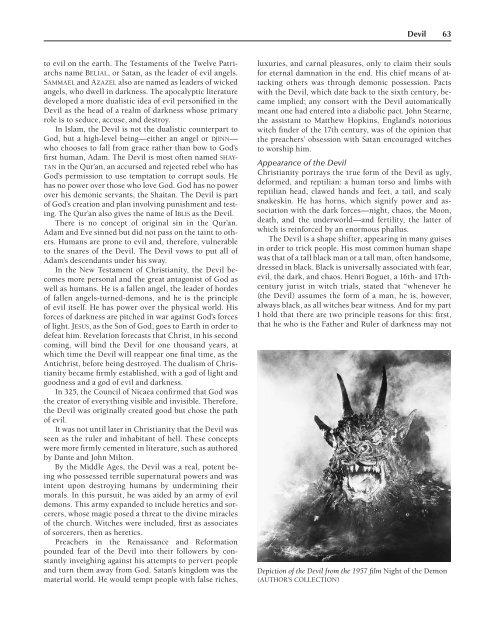The Encyclopedia Of Demons And Demonology
The Encyclopedia Of Demons And Demonology
The Encyclopedia Of Demons And Demonology
You also want an ePaper? Increase the reach of your titles
YUMPU automatically turns print PDFs into web optimized ePapers that Google loves.
Devil 63<br />
to evil on the earth. <strong>The</strong> Testaments of the Twelve Patriarchs<br />
name BELIAL, or Satan, as the leader of evil angels.<br />
SAMMAEL and AZAZEL also are named as leaders of wicked<br />
angels, who dwell in darkness. <strong>The</strong> apocalyptic literature<br />
developed a more dualistic idea of evil personified in the<br />
Devil as the head of a realm of darkness whose primary<br />
role is to seduce, accuse, and destroy.<br />
In Islam, the Devil is not the dualistic counterpart to<br />
God, but a high-level being—either an angel or DJINN—<br />
who chooses to fall from grace rather than bow to God’s<br />
first human, Adam. <strong>The</strong> Devil is most often named SHAY-<br />
TAN in the Qur’an, an accursed and rejected rebel who has<br />
God’s permission to use temptation to corrupt souls. He<br />
has no power over those who love God. God has no power<br />
over his demonic servants, the Shaitan. <strong>The</strong> Devil is part<br />
of God’s creation and plan involving punishment and testing.<br />
<strong>The</strong> Qur’an also gives the name of IBLIS as the Devil.<br />
<strong>The</strong>re is no concept of original sin in the Qur’an.<br />
Adam and Eve sinned but did not pass on the taint to others.<br />
Humans are prone to evil and, therefore, vulnerable<br />
to the snares of the Devil. <strong>The</strong> Devil vows to put all of<br />
Adam’s descendants under his sway.<br />
In the New Testament of Christianity, the Devil becomes<br />
more personal and the great antagonist of God as<br />
well as humans. He is a fallen angel, the leader of hordes<br />
of fallen angels-turned-demons, and he is the principle<br />
of evil itself. He has power over the physical world. His<br />
forces of darkness are pitched in war against God’s forces<br />
of light. JESUS, as the Son of God, goes to Earth in order to<br />
defeat him. Revelation forecasts that Christ, in his second<br />
coming, will bind the Devil for one thousand years, at<br />
which time the Devil will reappear one final time, as the<br />
Antichrist, before being destroyed. <strong>The</strong> dualism of Christianity<br />
became firmly established, with a god of light and<br />
goodness and a god of evil and darkness.<br />
In 325, the Council of Nicaea confirmed that God was<br />
the creator of everything visible and invisible. <strong>The</strong>refore,<br />
the Devil was originally created good but chose the path<br />
of evil.<br />
It was not until later in Christianity that the Devil was<br />
seen as the ruler and inhabitant of hell. <strong>The</strong>se concepts<br />
were more firmly cemented in literature, such as authored<br />
by Dante and John Milton.<br />
By the Middle Ages, the Devil was a real, potent being<br />
who possessed terrible supernatural powers and was<br />
intent upon destroying humans by undermining their<br />
morals. In this pursuit, he was aided by an army of evil<br />
demons. This army expanded to include heretics and sorcerers,<br />
whose magic posed a threat to the divine miracles<br />
of the church. Witches were included, first as associates<br />
of sorcerers, then as heretics.<br />
Preachers in the Renaissance and Reformation<br />
pounded fear of the Devil into their followers by constantly<br />
inveighing against his attempts to pervert people<br />
and turn them away from God. Satan’s kingdom was the<br />
material world. He would tempt people with false riches,<br />
luxuries, and carnal pleasures, only to claim their souls<br />
for eternal damnation in the end. His chief means of attacking<br />
others was through demonic possession. Pacts<br />
with the Devil, which date back to the sixth century, became<br />
implied; any consort with the Devil automatically<br />
meant one had entered into a diabolic pact. John Stearne,<br />
the assistant to Matthew Hopkins, England’s notorious<br />
witch finder of the 17th century, was of the opinion that<br />
the preachers’ obsession with Satan encouraged witches<br />
to worship him.<br />
Appearance of the Devil<br />
Christianity portrays the true form of the Devil as ugly,<br />
deformed, and reptilian: a human torso and limbs with<br />
reptilian head, clawed hands and feet, a tail, and scaly<br />
snakeskin. He has horns, which signify power and association<br />
with the dark forces—night, chaos, the Moon,<br />
death, and the underworld—and fertility, the latter of<br />
which is reinforced by an enormous phallus.<br />
<strong>The</strong> Devil is a shape shifter, appearing in many guises<br />
in order to trick people. His most common human shape<br />
was that of a tall black man or a tall man, often handsome,<br />
dressed in black. Black is universally associated with fear,<br />
evil, the dark, and chaos. Henri Boguet, a 16th- and 17thcentury<br />
jurist in witch trials, stated that “whenever he<br />
(the Devil) assumes the form of a man, he is, however,<br />
always black, as all witches bear witness. <strong>And</strong> for my part<br />
I hold that there are two principle reasons for this: first,<br />
that he who is the Father and Ruler of darkness may not<br />
Depiction of the Devil from the 1957 film Night of the Demon<br />
(AUTHOR’S COLLECTION)












